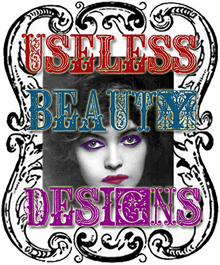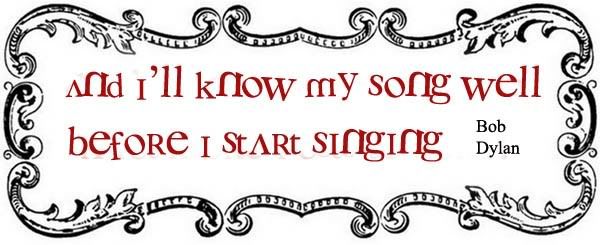 |
| Jo, still looking cheerful even though I'd made her do my questions |
We use a variety of art forms – painting and drawing, clay, musical instruments. On my placement in Fulbourn I see clients in an amazing room with a piano and drums, but normally we don’t have access to instruments quite like that! – Puppets are very popular, also I use a sand tray (placing things in it), and postcard images. I also sometimes use drama techniques, and movement and body work. Clients can bring in stuff that they think would be helpful – for example, clients often bring in music.
Choosing postcard images is very popular – clients often have some shame issues around creating art. They’re told at school that they’re bad at art and that stays with them. So clients choose images that represent a part of them, and then we talk that through.
[I asked Jo if anyone had ever wanted to express themselves through fibre crafts, and, interestingly: no-one ever had. I’m wondering if it’s because knitting (for example) isn’t a very immediate medium: not only does it take you forever to, say, express your irritation at someone by knitting a giant circular shawl with skulls on, on the final chart now, but, you have to learn how to do it first. But, I don’t know, and I imagine this varies for people].
2/ Do you find people have an initial resistence to expressing themselves through art?
People definitely do – particularly the clients I’ve worked with. Everyone’s a little bit apprehensive to start with. Often it’s because of their background – they’ve grown up thinking they’re not a very creative person. People might also have difficulty around being spontaneous and playful. Therapy is often about facilitating play. The power of using arts is that it has the potential to get straight to the unconscious, and that’s very exposing. There can be lots of transference from the client to the therapist. [We discussed here as well a bit about the fear of facing the blank canvas, or blank whatever: how perhaps the ultimate fear is that as soon as you make a mark you reveal your unconscious, and it’s not good enough. I realised that this is actually a difference between craft and art for me: with craft, I don’t have the facing-the-void problem. I just don’t have it. I don’t know if that’s an issue of media, what I’m expressing, or my own preconceptions, though].
3/ What types of issues do you find respond best to art therapy?
It tends to work well with exploring different aspects of the self, therefore, it’s useful for people with a fragmented sense of self. It’s good for people who are perhaps feeling flat and stuck, and want to live to their potential. I’ve also used it on people who are psychotic, although not all therapies are effective in that case: for example, where normally I might get someone to create an image and then journey into it, I would only do that if someone had a secure footing in reality. Music tends to be useful for psychotic patients: it gives structure.
4/ Do you think some people are intrinisically more creative?
I like to think that everybody is creative, although it might be more in some people’s temperaments – but there is also creativity in other things. There is creativity in living a good life, for example, not getting stuck in old patterns, and having the capacity to be in the moment. Art can be used as a kind of rehearsal for life, and if people have taken risks in the art relationship, they can then transfer that over to life.
5/ Do you think there is a difference between craft and art?
I started off as a textile artist, and I like the idea of fusing craft and art. It’s all about the aesthetic for me: if craftwork moves me then it’s the same to me as painting. I think the intention in creating the work is important.
6/ Do you think art and a well-balanced mental state necessarily go together? [I’m going to analyse myself now. I think this question is expressive of an anxiety that you lose some part of yourself through therapy and/ or becoming functional. Not to worry though, I think I’ve some way to go yet].
I think there’s a lot of romanticism about creativity and genius, and how they can come together, but I think in actual fact sometimes the more in touch someone becomes the more that layer of doubt and neurosis is taken away. [Jo explained she had undergone lots of therapy herself, as this is mandatory for anyone acting as a therapist to clients, and I shall now spare you my rant about how This Should Be The Case In All Voluntary Sector Professions Involving A Client-Professional Dynamic, although, I did not spare poor Jo: anyway, this had helped her a lot in confronting feelings of ambivalence towards her own art, e.g. the idea that she had to do art obsessively for it to count. I do think there’s a very strong cultural idea about the Mad Driven Artist which is actually worth unpicking if you think about it because also it’s generally post-1820 or whenever].
7/ What was your experience of working with Kids Company?
I worked in a couple of primary schools for Kids Company – it was inner-city London, and could be quite challenging. There were some difficult psycho-social issues, and people were quite resistent to therapy – it wasn’t in their culture. There was a lot of shame about admitting you might be struggling. It was very enriching though – clients enrich your practice – you learn a lot from them. Often people have very traumatic early beginnings, and it’s quite inspiring to see how they work their way through them.
8/ Tell me about the art you do!
I paint in oils – I do abstracts with a figurative dimension. I’ve exhibited with Changing Spaces – I used to have a studio when I lived in Leeds, but I don’t have one in Cambridge. I need to get back to it!
Thank you Jo! You were a lovely interviewee, and you gave me lots to think about. I am off to ponder what I am expressing and how, and I am also going to think about unhelpful Artist Stereotypes I might be holding on to. I am actually sitting here wondering what art forms I gravitate to naturally if I am actually trying to work through something emotional, and, I gravitate to writing and music (not saying I do either well, but, those are the ones I go for, and I shall be telling you about my adventures in guitar playing in a future post). And, interestingly, it is writing and music that have been difficult for me over these last couple of years. You see: lots to think about. Thank you again Jo and all the best with your practice and your painting!




















1 comments:
Great interview with great comments!
Post a Comment